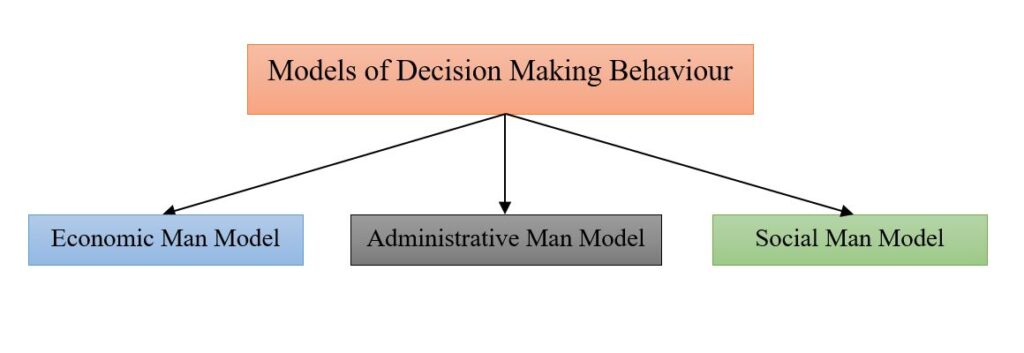Rationality in Decision Making
(Models of Decision-Making Behaviour)
The question of rationality has long engaged the attention of decision theorist. Some of them hold the view that a manager is completely rational in his decisions. Some say that he is completely irrational. Still other say that he exercises limited rationality. These three types of views on decision-making behavior are based on three models of man: economic man, administrative man and social man. Following is a description of these models.
1. Economic man model
The classical approach to decision making in economics has used the economic man model and is essentially a theory of decision making under conditions of certainty. The economic man is completely rational. It is characterized by the following features under economic man mode.
(a) The decision making is completely rational in the means-ends sense. Economic man always identifies clearly the ends to which he wants to reach and the means which are available for the purpose.
(b) Economic man is rational in that he can order his various preferences according to his hierarchy of values and then actually make his choice so as to maximize some desired value. Normally, this desired value would be equivalent to organizational goal attainment and the task goal of profit in particular if decision making is considered in organizational context.
(c) There is complete awareness of various alternatives and the outcome of each alternative can be identified so that the alternative with the best outcome is chosen. It assumes that there is no limit on the collection of information and its processing.
The economic man theory is closely related to the concept of organizational rationality. It is a normative theory rather than a descriptive theory because it is concerned with what a decision maker should do rather than what he actually does in reaching conclusion. In business context, the concept of economic man model cannot be applied because of two reasons.
i. The complete rationality is not possible because the conditions under which economic man makes decision are seldom available. The complete certain conditions do not really exist.
ii. Even if rationality is possible, it cannot be applied because it amounts to maximization of profit which is not possible because of so many pressures from the environmental forces.
2. Administrative Man Model of Bounded Rationality Model
A more realistic description of decision making behavior is based on the administrative man model which has been developed by Herbert Simon’s administrative man uses only limited rationality in his decisions because his informative-processing skills limited. Decision makers simply do not have full knowledge of all alternatives and their consequences. Therefore, there is certain amount of limit on rationality which has been called by Simon ‘bounded rationality’. Administrative man model of decision making is characterized by the following features:
i. In choosing among alternatives, administrative man attempts to satisfy or look for the alternative which is satisfying or good enough. Examples of satisfying criteria may be adequate market share, adequate profit, fair, price etc.
ii. Since administrative man believes in satisfying rather than maximizing, he can make his choices without first determining all possible alternatives and without ascertaining that these ae in fact all the alternatives.
iii. Administrative man is able to make decisions with relatively simple rules of thumb or tricks of traded, or from force of habit. These techniques do not make impossible demands upon his capacity for thought.
Thus, the basic difference between economic man and administrative man models is that the former goes for searching all the alternatives and tries to maximize out of his decisions while the latter continues to search alternatives until he finds one that meets some personality determined minimum acceptable level.
Simon’s administrative man model (also known as bounded rationality model) involves the following eight steps in the decision making process:
i. Set the goal to be pursued or define the problem to be solved.
ii. Establish appropriate criteria to judge the acceptability of a solution.
iii. Use heuristic to narrow down the field of search and identify a feasible solution.
iv. If no feasible solution is identified, then lower the criteria to judge the acceptability of a solution and begin the search afresh, repeating step 3.
v. If a feasible solution is identified, evaluate it to determine its acceptability.
vi. If the solution is found acceptable, implement it.
vii. If the solution is found unacceptable, initiate search for a new solution, repeating steps 3 to 5.
viii. Following implementation, evaluate the degree of difficulty with which the goal was or was not attained and raise or lower the criteria to judge the acceptability of a solution accordingly for future decision of this type.
3. Social Man Model
This model has been developed by classical psychologists. Freud, in particular says that men being a bundle of feelings, emotions and instincts is guided by his unconscious desires. He is also subject to social pressures and influences. Obviously, such a person is not capable of making rational management decisions. The well-known experiment by Solomon Asch demonstrates that thus world is full of irrational conformists. His study utilized several groups of seven to nine subjects each. They were told that their task was to compare the lengths of lines. All except one of the subjects in each group had pre-arranged with the experimenter to give clearly wrong answers on twelve of the eighteen line-judgement trials. About 37% of the 123 naïve subjects yielded to the group pressures and gave incorrect answers to the twelve test questions. Strong social pressures can similarly force managers also to choose obviously wrong alternatives. In all such case, their decisions cannot be termed as organizationally rational, though they may be personally rational, being oriented to their personal goals.


